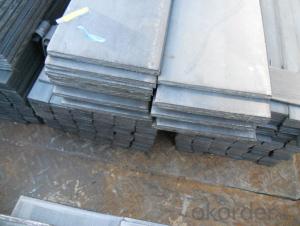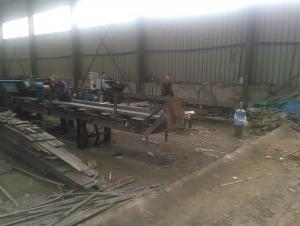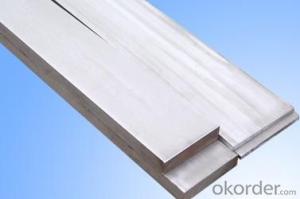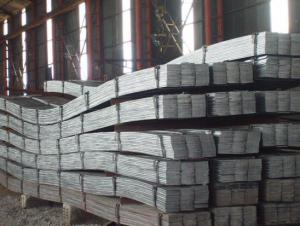Flat Steel Bars Grade SS400 ASTM A36
- Loading Port:
- Tianjin
- Payment Terms:
- TT or LC
- Min Order Qty:
- 50 m.t.
- Supply Capability:
- 10000T m.t./month
OKorder Service Pledge
OKorder Financial Service
You Might Also Like
Product Description:
OKorder is offering Flat Steel Bars Grade SS400 ASTM A36 at great prices with worldwide shipping. Our supplier is a world-class manufacturer of steel, with our products utilized the world over. OKorder annually supplies products to African, South American and Asian markets. We provide quotations within 24 hours of receiving an inquiry and guarantee competitive prices.
Product Applications:
Flat Steel Bars Grade SS400 ASTM A36 are ideal for structural applications and are widely used in the construction of buildings and bridges, and the manufacturing, petrochemical, and transportation industries.
Product Advantages:
OKorder's Flat Steel Bars Grade SS400 ASTM A36 are durable, strong, and wide variety of sizes.
Main Product Features:
· Premium quality
· Prompt delivery & seaworthy packing (30 days after receiving deposit)
· Can be recycled and reused
· Mill test certification
· Professional Service
· Competitive pricing
Product Specifications:
Manufacture: slited
Slitting precision (width) : 0.5 mm or less
Raw material: Q235B, Q345B, Q235-1 b
crosscutting precision (length) : 2 mm or less
Processing: the thickness of 2.0-16 mm;
Shear length: 2000 mm above
Wide degree: 15-1250 - mm;
Leveling precision: 1-2 MM square
Packaging: Export packing, nude packing, bundled
FAQ:
Q1: How many tons of steel products could be loaded in containers?
A1: Usually the steel products are delivered by bulk vessel because of the large quantity and the freight. However, there are no bulk vessel enter some seaports so that we have to deliver the cargo by containers. The 6m steel product can be loaded in 20FT container, but the quantity is changed according to the size, usually from 18tons to 25tons.
Q2: How do we guarantee the quality of our products?
A2: We have established an advanced quality management system which conducts strict quality tests at every step, from raw materials to the final product. At the same time, we provide extensive follow-up service assurances as required.
Q3: what is the difference between actual weight and theoretical weight?
A3: All the section steel has two weights: actual weight and theoretical weight. Actual weight is the weighing out when the product delivered from the mill. Theoretical weight is calculated by pieces. The invoice can be based on each of them as your request.
Images:


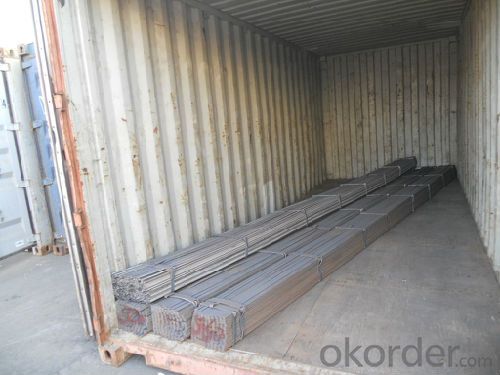
- Q: What are the safety precautions when handling steel flat bars?
- To ensure the well-being of those involved, it is important to take several safety precautions when dealing with steel flat bars. 1. Personal Protective Equipment (PPE) is crucial and should be worn to minimize the risk of injuries. This includes gloves, safety glasses, and steel-toed boots, which protect against cuts, eye injuries, and foot injuries. 2. Proper lifting techniques should be used to avoid strain or back injuries. Lift with your legs, not your back, and seek assistance if the weight is too heavy to handle alone. 3. Securely store and stack steel flat bars to prevent them from falling or toppling over. Use appropriate storage racks or shelves to keep them organized and eliminate potential hazards. 4. Handle steel flat bars with care as they often have sharp edges. Avoid dragging or sliding them across surfaces to prevent injuries. Rounding or deburring the edges can also reduce the risk of cuts. 5. Maintain fire safety by keeping the work area clear of flammable materials and having fire extinguishers available. Avoid using steel flat bars near open flames or other sources of ignition. 6. Proper training is essential for safe handling. Educate yourself and others on the correct techniques and precautions to minimize potential risks. 7. Regularly inspect steel flat bars for damage, such as cracks or corrosion, and replace any damaged bars to prevent accidents. By implementing these safety precautions, individuals can effectively reduce the risks associated with handling steel flat bars and create a safer work environment.
- Q: What are the different types of surface defects that can be found in steel flat bars?
- Some common types of surface defects found in steel flat bars are scratches, pits, scale, cracks, and rust.
- Q: What is the maximum thickness-to-width ratio for a steel flat bar?
- The maximum thickness-to-width ratio for a steel flat bar typically depends on the specific steel grade and industry standards. However, as a general rule, a common maximum thickness-to-width ratio for a steel flat bar is around 1:10.
- Q: How is a steel flat bar made?
- A steel flat bar is typically made through a process called hot rolling. The process begins with heating a large steel billet or slab to a high temperature, typically around 1200 to 1300 degrees Celsius. The heated billet is then passed through a series of rolling mills, where it is gradually flattened and shaped into a long, thin strip known as a flat bar. In each rolling mill, the steel billet is passed through a pair of rotating rolls, which exert pressure on the billet and gradually reduce its thickness. The billet is rolled multiple times, with the gap between the rolls getting smaller with each pass. This continuous rolling process helps to refine the grain structure of the steel, improving its strength and durability. After the desired thickness is achieved, the flat bar may undergo additional processes such as cooling, straightening, and cutting to the required length. Cooling is typically done using air or water to rapidly cool the steel and lock in its desired properties. Straightening helps to remove any bends or twists that may have occurred during the rolling process, ensuring a uniform flat shape. Once the flat bar is cooled and straightened, it is cut into individual lengths using shearing or sawing machines. These lengths can then be further processed or used as is for various applications. Overall, the production of a steel flat bar involves heating a steel billet, hot rolling it through a series of rolling mills to achieve the desired thickness, cooling, straightening, and finally cutting it into individual lengths. This process results in a versatile and widely used product that finds applications in industries such as construction, manufacturing, and automotive.
- Q: What are the typical applications of steel flat bars?
- Due to their versatility and strength, steel flat bars find a wide range of applications in various industries. In the construction sector, they are commonly used for structural support in buildings and bridges. The manufacturing industry also relies heavily on steel flat bars, utilizing them in the production of machinery, equipment, and tools. In the automotive industry, steel flat bars are frequently employed in the construction of chassis, frames, and body structures due to their excellent strength and durability. They are also extensively used in the fabrication of agricultural equipment like plows and harrows, as they can withstand heavy loads and harsh environments. The marine industry also heavily relies on steel flat bars. They are used in the construction of ship hulls and various marine components such as rudders, propellers, and anchor chains. The corrosion-resistant properties of stainless steel flat bars make them particularly suitable for marine applications. Steel flat bars are also crucial in the manufacturing of furniture, appliances, and storage systems. Their high strength-to-weight ratio allows for the creation of lightweight yet robust structures. Additionally, they are commonly used in the production of shelving units, brackets, and supports due to their load-bearing capabilities. In summary, steel flat bars have a vast and diverse range of applications in industries including construction, manufacturing, automotive, and marine. Their strength, durability, and versatility make them an indispensable component in various sectors.
- Q: Can steel flat bars be used in the construction of storage racks or shelves?
- Yes, steel flat bars can be used in the construction of storage racks or shelves. Steel is a strong and durable material that provides stability and support for storing heavy items. Flat bars can be easily shaped and welded to create the desired structure for storage racks or shelves, making them a suitable choice for this purpose.
- Q: What is the maximum temperature steel flat bars can withstand?
- The maximum temperature that steel flat bars can withstand depends on the specific grade of steel being used. However, in general, most steel flat bars can withstand temperatures up to around 1,000 degrees Celsius (1,832 degrees Fahrenheit) without experiencing significant structural changes or loss of strength. It is important to consult the manufacturer or specific technical data sheets for accurate temperature limits based on the grade of steel being used.
- Q: Are steel flat bars used in the construction of bridges?
- Steel flat bars are a common choice for bridge construction. These bars, also known as flat steel, are frequently used as structural components in bridges because they are strong, durable, and versatile. Typically made from carbon steel, these bars provide the necessary strength to support the weight and load of the bridge. They are incorporated into various bridge components, such as beams, trusses, and decking, to distribute the load and ensure stability, thereby maintaining the overall integrity of the bridge. Moreover, steel flat bars are highly resistant to corrosion, making them suitable for outdoor applications where bridges are exposed to environmental elements. In conclusion, steel flat bars play a vital role in bridge construction, contributing significantly to their strength, stability, and long-lasting nature.
- Q: How do steel flat bars perform in terms of fire resistance?
- The fire resistance properties of steel flat bars are excellent. When exposed to high temperatures, they do not easily deform or lose their structural integrity due to their high melting point. Steel's melting point is approximately 1370 degrees Celsius (2500 degrees Fahrenheit), which is significantly higher than typical fire temperatures. As a result, steel flat bars can maintain their strength and stability even in intense fire conditions. Moreover, steel does not aid in the propagation of fire because it is non-combustible. It does not release flammable gases or emit toxic fumes when subjected to fire, making it a safe option for fire-resistant applications. In addition, steel flat bars have a slow rate of heat transfer. This means that they can effectively act as a barrier, slowing down the spread of heat from the fire to the surrounding areas. This capability helps contain the fire and prevents it from spreading to other sections of a structure. Furthermore, steel flat bars are frequently utilized in fire-rated assemblies and construction systems, such as fire doors, fire-resistant walls, and fireproofing systems. These applications are specifically designed to meet specific fire resistance ratings and undergo thorough testing to ensure their ability to withstand fire conditions for a specific duration. Overall, steel flat bars are highly dependable and perform admirably in terms of fire resistance. They provide structural stability, do not contribute to the spread of fire, and are capable of withstanding high temperatures effectively. This makes them an ideal choice for fire-resistant applications in various industries.
- Q: How do steel flat bars contribute to the overall efficiency of healthcare structures?
- Steel flat bars contribute to the overall efficiency of healthcare structures in several ways. Firstly, steel flat bars are widely used in the construction of healthcare structures due to their strength and durability. This ensures that the buildings can withstand the test of time and provide a safe and secure environment for patients, staff, and equipment. Additionally, steel flat bars are highly versatile and can be easily fabricated into various shapes and sizes, allowing for efficient and precise construction. This enables healthcare structures to be designed and built according to specific requirements, optimizing the use of space and resources. Moreover, steel flat bars possess excellent fire resistance properties, which is crucial in healthcare structures where the safety of occupants is of utmost importance. By using steel flat bars in the construction, healthcare facilities can minimize the risk of fire incidents and ensure the protection of patients and staff. Furthermore, steel flat bars are known for their high load-bearing capacity, which is essential in healthcare structures that require the support of heavy equipment and machinery. This enables the buildings to accommodate advanced medical technology and infrastructure, such as MRI machines, surgical equipment, and patient lifts, without compromising structural integrity. Lastly, steel flat bars are relatively low-maintenance and resistant to corrosion, reducing the need for frequent repairs and replacements. This not only saves costs but also minimizes disruptions to healthcare services, allowing medical professionals to focus on providing quality care to patients. Overall, steel flat bars play a crucial role in enhancing the efficiency of healthcare structures by providing strength, versatility, fire resistance, load-bearing capacity, and low-maintenance characteristics.
Send your message to us
Flat Steel Bars Grade SS400 ASTM A36
- Loading Port:
- Tianjin
- Payment Terms:
- TT or LC
- Min Order Qty:
- 50 m.t.
- Supply Capability:
- 10000T m.t./month
OKorder Service Pledge
OKorder Financial Service
Similar products
Hot products
Hot Searches
Related keywords














